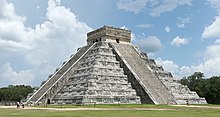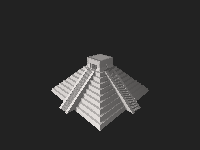| El Castillo, Chichen Itza | |
|---|---|
 North-west view of El Castillo | |
| Ancient name | Kukulcan |
| Constructed | 8th–12th century AD |
| Type | Mesoamerican step pyramid |
| Material | Limestone |
| Height | 24 m (79 ft), without temple 30 m (98 ft), with temple 6 m (20 ft), Temple itself |
| Base | 55.3 m (181 ft) |
| Slope | 37°29'44" (edges) 47º19'50" (sides) |
| Location | Tinum Municipality, Mexico |
| Part of | Pre-Hispanic City of Chichen-Itza |
| Criteria | Cultural: (i), (ii), (iii) |
| Reference | 483 |
| Inscription | 1988 (12th Session) |
| Coordinates | 20°40′58.4″N 88°34′7.0″W / 20.682889°N 88.568611°W |
El Castillo (Spanish pronunciation: [el kas'tiʎo], 'the Castle'), also known as the Temple of Kukulcan is a Mesoamerican step-pyramid that dominates the center of the Chichen Itza archaeological site in the Mexican state of Yucatán. The temple building is more formally designated by archaeologists as Chichen Itza Structure 5B18.
Built by the pre-Columbian Maya civilization sometime between the 8th and 12th centuries AD, the building served as a temple to the deity Kukulcán, the Yucatec Maya Feathered Serpent deity closely related to Quetzalcoatl, a deity known to the Aztecs and other central Mexican cultures of the Postclassic period. It has a substructure that likely was constructed several centuries earlier for the same purpose.
The temple consists of a series of square terraces with stairways up each of the four sides to the temple on top. Sculptures of plumed serpents run down the sides of the northern balustrade. Around the spring and autumn equinoxes, the late afternoon sun strikes off the northwest corner of the temple and casts a series of triangular shadows against the northwest balustrade, creating the illusion of the feathered serpent "crawling" down the temple. To contemporary visitors, the event has been very popular and is witnessed by thousands at the spring equinox, but it is not known whether the phenomenon is a result of a purposeful design since the light-and-shadow effect can be observed without major changes during several weeks near the equinoxes.[1]
Scientific research led since 1998 suggests that the temple mimics the chirping sound of the quetzal bird when humans clap their hands around it. The researchers argue that this phenomenon is not accidental, that the builders of this temple felt divinely rewarded by the echoing effect of this structure. Technically, the clapping noise rings out and scatters against the temple's high and narrow limestone steps, producing a chirp-like tone that declines in frequency.[2][3]
All four sides of the temple have approximately 91 steps which, when added together and including the temple platform on top as the final "step", may produce a total of 365 steps (the steps on the south side of the temple are eroded). That number is equal to the number of days of the Haab' year and likely is significantly related to rituals.[4]
The structure is 24 m (79 ft) high, plus an additional 6 m (20 ft) for the temple at the top. The square base measures 55.3 m (181 ft) across.
- ^ Šprajc, Ivan; Sánchez Nava, Pedro Francisco (2018). "El Sol en Chichén Itzá y Dzibilchaltún: la supuesta importancia de los equinoccios en Mesoamérica". Arqueología Mexicana. XXV (149): 26–31.
- ^ Jennie Cohen, Did the Maya Build Chirping Pyramids?, History.com, 17 November 2010
- ^ David Lubman, Archaeological acoustic study of chirped echo from the Mayan temple at Chichen Itza, in the Yucatan Region of Mexico ... Is this the world's oldest known sound recording?, Acoustics.org, 13 October 1998
- ^ Milbrath 1989: 66

